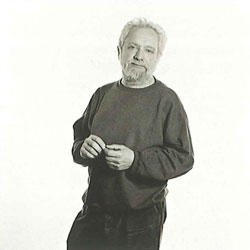Alberto Carneiro
Alberto CarneiroCoronado ¶ 1937
 |
|
| Créditos fotográficos / Photographic credits: Abílio Leitão |
He was born in a small village in Minho, in northern Portugal, where he worked from 1947 to 1958 in several sacred art workshops that helped him to develop his sculpting techniques on wood, stone and ivory. He studied at the Decorative Arts Schools of Soares dos Reis (Porto) as well as that of António Arroio (Lisbon), and later went on to acquire a degree in Sculpture at the Fine Arts School of Porto. He eventually did a Master's at London's Saint Martin's School of Art. Since the late 60s, Carneiro's actions have been interdisciplinary focused upon a somewhat playful idea of recognizing the individual in the world, engendered from the cosmos that is represented in nature. ¶ During his stay in London, he came across with Anthony Caro's sculptures, and was swayed by the general aesthetic and ideological experiences of the 60s, namely the British chapter of Minimal and Conceptual art. This would trigger his own development of what would be innovative projects within the Portuguese milieu: O canavial: memória metamorfose de um corpo ausente (The marsh: memory metamorphosis of an absent body, 1968) and Uma floresta para os teus sonhos (A forest for your dreams, 1970) expose a special tendency towards the values of an "involving" art, one that discards the pre-eminence of manual labour for the reflection on the conceptual project, a progressive dematerialization of the work of art. This anthropological stance on artistic activities was done in tandem with an approach to the oriental philosophies of essence and nature (such as Zen Buddhism and Tantrism), which lead Carneiro to write a Manifesto da Arte Ecológica (Ecological Art Manifesto, 1968-72) the major key-notions of which are the refutation of the Westerner's sensuality/spirituality dualism and the promotion of "a rehabilitation of the simplest things in the significance of aesthetic communication". ¶ From all the projects of that period, we should stress the (Land Art-inspired) landscape interventions such as Operação Estética em Vilar do Paraíso (Aesthetical Action in Vilar do Paraíso, 1973), a minimal action done with a few hay rolls, or Operação Estética em Caldas de Aregos (Aesthetical Action in Caldas de Aregos), in which the artist engraved (branded) a stone with a spiral symbol, as well as with his signature and date (naming and possession-taking). A craving for origin and a returning to cosmic essences is evident in this work, and it maybe translated as an extreme, pure nature calling, something that lies between acting and reflecting, and can visualise the unity of body and matter.
View the embedded image gallery online at:
http://cvc.instituto-camoes.pt/biografias-en/alberto-carneiro-86815-dp2.html#sigFreeIde74fd2482f
http://cvc.instituto-camoes.pt/biografias-en/alberto-carneiro-86815-dp2.html#sigFreeIde74fd2482f


